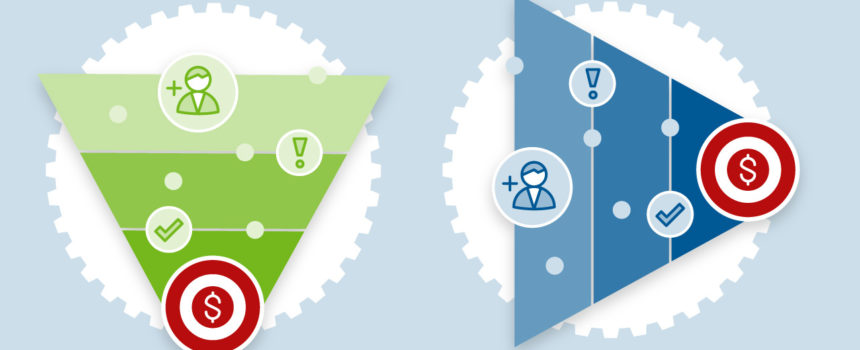Okay, this might seem to be a strange title for an article. But knowing the clear difference between a sales funnel and a sales pipeline can mean a great deal to your company, your sales organization, and your salespeople—and greatly influence your choice of a CRM solution.
The Sales Funnel
We’ve all seen a funnel. Pour water through it, and gravity pulls the water from the top to the bottom. Unfortunately,this demonstration, based on natural law, has been borrowed from science and applied to sales. The concept is that if leads are poured through the top of a sales funnel, they almost automatically (like water) fall through the funnel and become opportunities as they fall. Some will reach the bottom as closed sales.
There is a major problem with this concept: within sales, gravity doesn’t exist. Where you have a high number of leads, there is no assurance at all that they will turn into opportunities on the way down, and close as they come out the bottom. For leads to develop into opportunities, a live person must be actively involved with every step of the process.
The Sales Pipeline
If you look at how sales are actively made, you’ll see that the concept of a sales pipeline is much closer to reality. Leads come in on the left side and are actively moved through the pipeline’s stages. Salespeople are applying their skills at every stage.
For that pipeline to work, it must be based on an established and successful sales process. A sales process is that exactly prescribed series of steps that a sale must pass through from lead all the way to a close. A sales process is normally developed out of the successful sales methods of proven reps, so that new and lesser experienced salesperson can stick to sales actions that have worked well. Sales management is also greatly assisted by a sales process as the whole team will be on the same page.
Choice of CRM Solution
Because it isn’t a reflection of how salespeople actually work, any CRM application based on the sales funnels concept won’t be intuitive or logical, and won’t end up being used. In order to track sales, sales reps end up resorting to their own solutions such as notes or spreadsheets—and when this happens the data from these is unavailable to the remainder of the team and, most importantly, the sales manager. For management, this leads to a great deal of time wasted chasing up numbers and obtaining sales status reports.
A CRM solution works best when based on the concept of the sales pipeline. That means that it intuitively and logically mirrors a company’s sales process, and expresses it visually. If done right, any opportunity can be rapidly located within its appropriate pipeline stage.
Such a tool is a powerful enabler for salespeople—and in fact it will be found that they actually enjoy using it. Recording and retrieval of data is easy because that data fits logically into CRM. A salesperson can rapidly view their pipeline and quickly estimate what is needed to finish off a successful month or quarter. And best of all, sales reps are on top of their sales and in control—in every way.
CRM designed this way also eases the burden of sales management considerably. Instead of having to constantly chase up data from salespeople, management can obtain everything they need right from the CRM solution.
Have a look at your sales operation and CRM: is it a sales funnel, or a pipeline? Turn it into the latter, and watch your sales soar.






















Comments (1)
Brilliant article with the fresh new look on this problem. Now I am seeing a clear difference between sales pipeline and sales funnel. Thanks for that, now I can choose the right CRM for my company. I also want to recommend some additional source of my knowledge about sales pipeline: http://righthello.com/sales-pipeline-management/ – where you find information which can be valuable for your, maybe you will use it to improve your post. Anyway, great job!